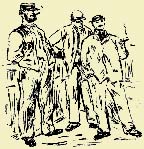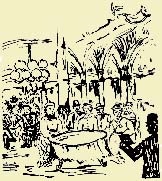|
HELPFUL HINTS FOR STEAMBOAT PASSENGERS |
||||||||||||||||||||||||||||||||||||||||||||||||||||
|
|
||||||||||||||||||||||||||||||||||||||||||||||||||||
|
Helpful Hints for Steamboat Passengers is published as a service for the traveling public. Careful attention to its information and suggestions will insure the riverboat patron a memorable journey. The make‑believe guide contains sample fares. It describes the many accommodations found on steamboats. It lists the services provided by the crew. Warnings are given about possible unpleasant situations. Steamboat travel is the finest type of transportation. Sturdy packets ply the waters of the nation's major rivers. Amazing technical advances have made possible the best in travel luxury. No other form of travel is so economical. Yet some people are now accepting the new unnatural form of travel. This guide provides the reader with important reasons to avoid the fiendish railroad cars. The misguided fail to understand how the railroad is against God's Holy Law and Nature. But if the public is well‑informed, the railroad will soon disappear like other passing fads. |
||||||||||||||||||||||||||||||||||||||||||||||||||||
|
DEPARTURE TIME |
||||||||||||||||||||||||||||||||||||||||||||||||||||
|
Packet and line boats leave terminal ports on scheduled time. The arrival and departure times change at ports along the river. Many tramp steamers do not keep regular schedules. Steamboat captains like to leave early in the morning. This gives them as many daylight hours as possible. Most captains do not like to operate at night unless the moon is very bright. There is too much danger in navigating in the dark, especially in low water. |
||||||||||||||||||||||||||||||||||||||||||||||||||||
|
||||||||||||||||||||||||||||||||||||||||||||||||||||
FARESThe steamboat traveler will find that fares change with the seasons. With‑high water (Spring and late Fall), the fare is low. As the water level drops (July and August) fares rise. The number of boats on the river affects the amount charged passengers. With many boats, the fare will be lower. As the number of operating boats drops, the fare will be higher. |
||||||||||||||||||||||||||||||||||||||||||||||||||||
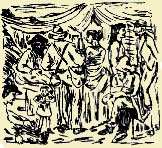 |
Cabin passengers pay more than deck passengers. The cabin passengers are assigned a stateroom and eat their meals in the dining saloon. The stateroom, with berth and meals, is included in the fare. Deck passengers remain on the lower deck. They make their own beds or sleep on the floor of the deck. They may bring their own food on board. |
|||||||||||||||||||||||||||||||||||||||||||||||||||
|
Steamboat travel today is a good bargain. Although the fares change, these examples will give the traveler a good idea of prices: |
||||||||||||||||||||||||||||||||||||||||||||||||||||
|
First Class Fares From St. Louis |
||||||||||||||||||||||||||||||||||||||||||||||||||||
|
To: |
Keokuk, Iowa Burlington, Iowa Davenport, Iowa Lyons, Iowa Galena, Illinois Dubuque, Iowa Guttenberg, Iowa Prairie Du Chien, Wisconsin St. Paul, Minnesota |
2.50 3.00 4.25 4.75 5.25 5.75 6.00
6.40 |
||||||||||||||||||||||||||||||||||||||||||||||||||
| Deck passage is usually one‑half of cabin fare | ||||||||||||||||||||||||||||||||||||||||||||||||||||
|
|
||||||||||||||||||||||||||||||||||||||||||||||||||||
CABINSCabin passengers enjoy the best of steamboat travel. The staterooms are on the cabin deck. They may be very narrow with only a bed against one wall and a dresser against the other. On some steamboats, the staterooms are larger. The typical cabin may be seven or eight feet square. On some of the new steamers the cabin may be nine or ten feet square. The modern steamers have staterooms with doors at each end, with one to the cabin, the other to the deck. The improved steamers provide clean mattresses and sheets on the berths. Curtains at cabin windows provide privacy to the passenger while dressing. |
||||||||||||||||||||||||||||||||||||||||||||||||||||
The Grand SaloonThe main attraction for the cabin passengers is the saloon. The saloon is as long as the cabin deck, with some as long as 200 to 300 feet. It is usually 17‑20 feet in width. Sometimes it is 12‑14 feet high. The saloon is richly decorated and furnished in the better steamers. One finds Brussels or Persian carpets, fine furniture, game tables, a piano in the saloons of the new passenger steamers. The cabin floor dining room is at one end of the saloon. Even the freight‑carrying steamers provide good accommodations for the cabin passengers. |
||||||||||||||||||||||||||||||||||||||||||||||||||||
|
Toilet Facilities
The toilet facilities are
vastly improved on the new craft. Some have a washstand and basin in each
of the staterooms. However, on the older craft, the two wa |
||||||||||||||||||||||||||||||||||||||||||||||||||||
|
|
||||||||||||||||||||||||||||||||||||||||||||||||||||
| DECK PASSAGE | ||||||||||||||||||||||||||||||||||||||||||||||||||||
|
The traveler with little money will find deck passage suited to his pocketbook. The average deck fare is 1/4 cent per mile, with rates as low as 1/6; cent' per mile. However, deck passage may be very rough. The main deck has the boiler, fuel, and cargo. Most steamboat captains load the cargo, including animals, on the deck first. Then the deck passengers scramble for the space that is left. Find boxes or bales marked for port farther than your own destination. These should make a good bed for your journey. With luck you will find a crate with cargo piled higher on at least one side of it. In this way, you will be sheltered from the wind and rain. If you can, avoid the boat's guards. The danger of being pushed overboard is too great. There is little or no protection from the elements. |
||||||||||||||||||||||||||||||||||||||||||||||||||||
| Meals | ||||||||||||||||||||||||||||||||||||||||||||||||||||
|
Deck passengers can cook their
own meals on stoves provided by the captain. However, it i The ship's officers reserve the right to move deck passengers from one side of the boat to the other. With uneven weight loads, the boat may list too much on one side. Do not get in the way of the officers or the crew. |
||||||||||||||||||||||||||||||||||||||||||||||||||||
|
Wooding |
||||||||||||||||||||||||||||||||||||||||||||||||||||
|
A passenger can reduce his fare by wooding on a trip. A trip from Pittsburgh to St. Louis may only cost two dollars; from St. Louis to Galena, only a dollar. The job of cutting and carrying wood is a hard one. It should be attempted by only those used to hard work. The crew will also need help in scooping animal manure off the deck. Most captains try to clean the deck once each day. |
||||||||||||||||||||||||||||||||||||||||||||||||||||
|
Boilers |
||||||||||||||||||||||||||||||||||||||||||||||||||||
|
Deck passengers are in constant danger from possible boiler explosions. Escaping steam from broken pipes may scald the passengers. If the boat is too crowded, passengers may be shoved overboard. In case the boat sinks, deck passengers may be trapped by the cargo. Life as a deck passenger, by any standard, is very unpleasant. The savings on fare is the only good feature of deck passage. Many river travelers avail themselves of deck passage. Deck passengers outnumber the cabin passengers by three to one, even as much as five to one. In the years of heavy immigrant flows, a boat may have 40 cabin passengers and 200 deck passengers. |
||||||||||||||||||||||||||||||||||||||||||||||||||||
| MEALS | ||||||||||||||||||||||||||||||||||||||||||||||||||||
|
The
fine packet boats between St. Louis and St. Paul are f |
||||||||||||||||||||||||||||||||||||||||||||||||||||
| Shore Restaurants | ||||||||||||||||||||||||||||||||||||||||||||||||||||
Shore RestaurantsIt is possible to go ashore at port cities. Meals are available at shore restaurants. Fresh fruits and vegetables may be bought from stands near the wharves. Deck passengers may take their own food on board. Some boats have stoves on the boiler deck. Space on the stove may be shared with other passengers. If deck passengers want to purchase a meal from the cabin deck kitchen, they are charged 25 cents. However, they eat with the crew, not the cabin passengers. |
||||||||||||||||||||||||||||||||||||||||||||||||||||
|
HOTELS AND RESTAURANTS |
||||||||||||||||||||||||||||||||||||||||||||||||||||
|
The major cities boast fine hotels and restaurants. Steamboat captains will recommend the best hotels and will arrange transportation to the hotel. Most of these hotels are located near stage depots. This helps the traveler to transfer from steamer to stage. The traveler will find good accommodations for 50 cents per night. First class hotels may charge from 75 cents to a dollar. Most western hotels operate on the American Plan, with meals included in the price of the room. The hotel desk clerk will awaken you in time for an early morning stage or steamer. Both stage drivers and steamboat captains like to have as many hours of daylight as possible. Stages will leave from 4:00 to 6:00 a.m. Steamers will be on their way before 6:00 a.m. Even in the best hotels, guests are robbed. Be sure to lock your room. Bolt the door upon retiring. Some travelers tilt a chair so its top fits under the door knob. This will help to block the door. |
||||||||||||||||||||||||||||||||||||||||||||||||||||
|
||||||||||||||||||||||||||||||||||||||||||||||||||||
|
CLOTHING Deck passengers should wear only coarse clothing. One should be prepared to sleep in his or her clothes. There will be few opportunities or few reasons to change clothes during the trip. Cabin passengers will want to wear good street clothes on boarding. Several changes of clothes are appropriate. Ladies will want to have suitable morning dress as they promenade around the cabin deck. Evening apparel is expected for dinner and the entertainment in the main saloon of the cabin deck. Gentlemen will want to dress for the evening events on board. Valets and chambermaids will take care of cleaning, brushing, and pressing women's gowns and gentlemen's suits. They will polish shoes. They will launder and iron the washable articles of clothing. |
||||||||||||||||||||||||||||||||||||||||||||||||||||
|
RELIGIOUS OBSERVANCES |
||||||||||||||||||||||||||||||||||||||||||||||||||||
|
'Keep Holy the Sabbath Day'
Many steamboat captains refuse
to operate on the Sabbath. These God‑fearing men will no If the boat is between landings, the captain will conduct religious services. Men of the cloth are invited to preach the sermon. The captain will lead the singing of hymns and will read the Scriptures. Some boats have pianos or organs. There may even be a band on board. Most steamers will dock in town on Saturday evening. The captain will direct passengers to the church of their choice on Sunday morning. The traveler will find the fellowship of western congregations to be truly inspiring. |
||||||||||||||||||||||||||||||||||||||||||||||||||||
|
||||||||||||||||||||||||||||||||||||||||||||||||||||
| RACES | ||||||||||||||||||||||||||||||||||||||||||||||||||||
|
Sometimes the steamboat passenger is treated to a race between two fast river boats. Competing captains want to show the speed of their craft. Merchants and travelers like to know which boats will reach their destination in the shortest time. Recent technical advances have made possible daring feats of speed on the rivers. During the 1840's, Captain David Smith Harris broke many records with his War Eagle. In 1845, he plied the distance between St. Louis and Galena in 43 hours and 45 minutes. By 1849, Captain Harris made the trip downstream in only 33 hours. |
||||||||||||||||||||||||||||||||||||||||||||||||||||
|
Die Vernon vs. West Newton |
||||||||||||||||||||||||||||||||||||||||||||||||||||
|
Last year, this same Captain Harris competed against the famous Die Vernon. He pitted his West Newton with the queen of the Keokuk Packet line in a race between Galena and St. Paul. Fans of both captains are still arguing about the event. Harris' West Newton led all the way until the two boats reached Lake Pepin, The Die Vernon passed Harris' boat in the lake. It went on to win the race by reaching St. Paul first. However, Captain Ford (Die Vernon) made a dishonest agreement with Captain Louis Robert (Greek Slave) to take fuel intended for Harris' craft. The statistics show the closeness of the race. The Die Vernon took 28 hours between Dubuque and St. Paul, a distance of 265 miles. This averages to 9.4 miles per hour. The West Newton averaged 9.1 miles per hour from Galena to St. Paul, a distance of 288 miles. At the end of the race, Captain Russell Blakeley, of the Nominee challenged the Die Vernon. Blakeley, led Ford all the way to Dubuque. Thus, in a way Captain Harris had his revenge. |
||||||||||||||||||||||||||||||||||||||||||||||||||||
|
ENTERTAINMENT |
||||||||||||||||||||||||||||||||||||||||||||||||||||
|
The luxury packet on Iowa's major rivers provide entertainment for their passengers. Most captains arrange to have bands on board. Some, like Captain Ford of the Die Vernon have a permanent band. The Die Vernon has 25 musicians. Often the crew makes up the band. The bands play during the evening hours and on entering and leaving port. The crews often sing during their work. Their songs describe their feelings and their hopes. Many times the verses are made up as they sing. Traveling theater troupes give shows while on board the modern steamers. Shakespearian actors are pleased to perform if requested. The evening passes much faster with drama or music. |
||||||||||||||||||||||||||||||||||||||||||||||||||||
|
||||||||||||||||||||||||||||||||||||||||||||||||||||
|
RAFTS ON THE UPPER MISSISSIPPI RIVER |
||||||||||||||||||||||||||||||||||||||||||||||||||||
|
The steamboat traveller will likely see one or more rafts on their way to one of Iowa's sawmills. Since 1838, lumber has been one of the chief products shipped downstream. At first, lumbermen rafted sawed lumber to Iowa's port cities. However, gradually they sent logs to be sawed at Dubuque, Clinton, Davenport, Muscatine, Burlington, Fort Madison, and Keokuk. The rafts will vary in size. Some contain as little as 100,000 feet while others will have as much as 800,000 feet. One Mississippi River raft this past year measured 144 feet wide and 380 feet long. Sometimes they join together to form a fleet of rafts. The fleet of rafts will have a cook shanty on one of the rafts. Food will be sent tothe others on a skiff. The men will bed down on the logs at night. Raftin' takes rough and tough young men. They have to put up with many hardships on their trips downstream. When they reach port, they are ready to celebrate at the local taverns. |
||||||||||||||||||||||||||||||||||||||||||||||||||||
|
|
||||||||||||||||||||||||||||||||||||||||||||||||||||
|
||||||||||||||||||||||||||||||||||||||||||||||||||||
|
STEAMBOAT AND RAILROAD TRAVELING |
||||||||||||||||||||||||||||||||||||||||||||||||||||
|
A Contrast From the Davenport Gazette, August 23, 1854 |
||||||||||||||||||||||||||||||||||||||||||||||||||||
|
We cannot see with what grace anyone traveling by railroad from St. Louis to this city can ever recommend that route to a friend in preference to the one by the river. We sit down for the purpose of giving an off‑hand sketch of the relative merits of the two modes of travel, having recently "put on" both, and thus show the superiority of the river route. In the first place, then, to begin with the river, you embark at St. Louis in one of the fine Keokuk packets, fare $4.00 with excellent accomadations for eating and sleeping, and in about 30 hours you are landed at Keokuk where you find awaiting you a superior line of four‑horse coaches. Entering one of these, in an hour and 30 minutes you are landed at Montrose for the moderate sum of 50 cents. Here you get aboard one of the Davenport packets and for an additional $4.00, and within 48 hours from the time you left St. Louis, are deposited, "right side up, with care"‑‑no bars aboard‑‑in Davenport. Thus for $8.50, very pleasantly, agreeably and sociably, you make the transit between the two cities. Now mark the other route. You call upon the Agent in St. Louis, who for $5.50 gives you a ticket to La Salle, Ill., the bounds of his Railroad jurisdiction. Embarking on the Alton packet, about 4 o'clock you start for that stone city. Soon you observe preparations for supper aboard and feel truly grateful for the wise provision made by the Company for the hungry traveler. You sit down and have scarcely got your tea sweetened to your taste, when the whole romance of the affair is taken off by a gentleman presenting himself at your elbow and stating that he will take that half dollar! You interrupt the pathos of eating by the pathos of "shelling out," and then proceed to perform the obsequies to some defunct fowl. Alton is reached and an omnibus in waiting conveys you to the station of the Mississippi railroad, where to you astonishment you learn that there is no charge made for that last act of kindness. You then enter the cars and soon are whirling over the "kedntry" at the rate of 20 miles to the hour. About 2 o'clock in the morning you find yourself at Bloomington, Ill. where for another half dollar, if you please, you can take a lunch; but without including this in the estimate of expenses, we have thus far $6.00. After waiting a reasonable time for the spirit to move somebody to reply to your anxious inquiry, `What is next to be done,' you tote your baggage around to the rear of the hotel, where you find a very animated discussion going on as to which of the runners congregated there shall have the honor of conducting you to the best hotel in the city. Choosing the Pike House, because the young man says it is a new hotel, and you therby argue that it has not yet got its full complement of occupants per bed, you jump into the 'bus; but before jumping out at your destination, which is three‑fourths of a mile distant, you are modestly informed by the aforesaid young gentleman that he will take those 15 cents. Rather marvelling that they should charge for conveying you to a hotel, you mount the steps and enter a very tidy looking, three‑story, well finished wooden building. Here you are informed, if you didn't know it before, that the cars do not leave until 1/2 past 8 o'clock, but that in the meantime you can turn in, take a snooze, then a breakfast and be in readiness for them. You are soon ensconced between sheets and before you have got cleverly underway towards the Land of Nod, are aroused by a noise that in your half‑waking condition makes you think that China and all the balance of creation have come together in one grand, gong exhibition and the tympanums of your ears are the fields of contest. You quickly don your unmentionables, if you didn't happen to sleep in them for fear you wouldn't have money enough to take you home, perform your ablutions and hasten down to breakfast. A cup of coffee and a warm biscuit fill up the cavity, which is the source of so much uneasiness one way or another to us all, and you prepare to depart; before doing so, however, you ask the gentleman who presides over the water jar the amount of your bill, when to your great convenience, as by this time you must have exhausted your small change, he informs you it is just one dollar! Though the proprietor may have informed you previously that you cannot expect from him such entertainment as given in hotels in St. Louis and Chicago, he forgets to acquaint you that you may expect such prices. Though the bill is exorbitant we must do the females of the house justice, by asserting that while the sheets were the cleanest, the coffee and biscuits were the best we ate in our travels, and make ample amends for the heavy charge. Again the 'bus drives up to the steps, when the driver, emboldened by your former pliability, informs you that he will take 15 cents before he starts and then he'll be sure of his fare. You have pleanty of time between jolts to calculate your expenses thus far before you reach the depot, and find them just $7.30. After traveling another three‑quarters of a mile you are deposited at the depot and soon enter the vacant cars of the Illinois Central Railroad. You now sit down and solace yourself with the reflection that but one more transfer and you will reach your destination; but alas! as oft as man sets up the pins of anticipation the ball of fate knocks 'em down! Previous to reaching La Salle a conductor takes your ticket and gives you another, which says, `Good for a free passage from Shippingport to La Salle.' Before you are posted with regard to the meaning of that little "shingle," you find yourself at a depot and everybody decamping as though the car was on fire. Seizing your carpetbag you run out and find yourself at the top of a steep decent. Not willing to trust yourself on a platform car, lowered down the steep by ropes, so long as you have a little wife and your children at home, you foot it about a half mile to where stands puffing and snorting a petty little locomotive with a car attached. You enter and so soon as the platform with the baggage arrives, away you speed, faster than a horse can walk. Thus you rush across the plain to La Salle where you are again beseiged by the noisiest, most impudent and lying pack of "runners" this side of St. Louis. If as fortunate as ourself, you enter a carriage, though you have to sit in a gentleman's lap, and are driven to the station and politely disembarked without any further expense. If as unfortunate as others going towards Chicago, you are duped into paying 25 cents and arrive at the depot just in time to see your friends scudding over the prairies‑‑some of them under barerpolls‑at the rate of 30 miles to the hour. Here you buy a ticket to Rock Island for $2.45 and have time to take a cup of exorable coffee and a slice of stale bread for an additional 50 cents. Soon the cars come rushing along and, jumping in, you are whirled on a model railroad to Rock Island. Seizing your carpetbag you walk down to the ferry, pay your half dime, cross over, walk up to the La Claire House and then and there calculate your expenses; when including a dime or two given the beggars on the Alton packet and expended for fruit on the way, you find them to net just $10.50. You retire to bed wearied, exhausted, and out of humor, determined never again to be seduced into taking that route, unless pressing necessity compels you. |
||||||||||||||||||||||||||||||||||||||||||||||||||||
|
ICE STOPS RIVER TRAFFIC |
||||||||||||||||||||||||||||||||||||||||||||||||||||
|
Every winter Iowa's great rivers freeze over. The normal flow of commerce stops. Merchants stock up for the winter trade. Travelers plan to reach their destination before the end of the season. Old‑time residents of river towns can recall the many hardships endured before regular steamboat service. Often the river froze before the last steamer arrived with winter supplies. The northern ports, like Dubuque and Galena, are frozen before the southern ports, like Burlington and Muscatine. The dates for closing the river and re‑opening it for commerce change from year to year. This report of the opening and closing of the Mississippi River at Muscatine is provided for the information of the reader. Consult this table if you are planning a trip during the winter months. |
||||||||||||||||||||||||||||||||||||||||||||||||||||
|
Opening and Closing of
Navigation |
||||||||||||||||||||||||||||||||||||||||||||||||||||
|
||||||||||||||||||||||||||||||||||||||||||||||||||||
|
IOWA'S EARLY RIVER TRANSPORTATION HISTORY |
||||||||||||||||||||||||||||||||||||||||||||||||||||
|
River transportation played an important role in Iowa's early exploration and settlement. The first Europeans came to Iowa by way of the Mississippi and Missouri Rivers. Some used the northern route. They left the Great Lakes and paddled canoes through the Wisconsin waterways. They portaged their canoes and cargoes between the lakes and rivers or from river to river. Others floated down the Ohio to the Mississippi and moved upstream past St. Louis. French and Spanish explorers and traders navigated the Upper Mississippi for a century prior to United States ownership of Iowa. Louis Joilet and Father Marquette found the river in their journey of 1673. During the next century, fur traders crossed it in their search for wealth. The Spanish land grantees, Julien Dubuque, Louis Tesson, and Basil Giard started the use of the Mississippi as a trade medium. In 1804, Captain Meriwether Lewis and Captain William Clark explored the Missouri River. With a large boat and two pirogues, they pushed their way past western Iowa. The next year (1805), Zebulon Pike headed an expedition to locate the source of the Mississippi River. He used a large 70‑foot keelboat with sail and oars. His record of the journey described the hardships faced by the upstream traveler. With a favorable wind, he made twenty miles in a day. Otherwise, his crew pushed the boat against the current with poles. Severe winter caused much discomfort for Pike and his crew, sand bars and logs slowed their progress. After a winter at Leech Lake, Minnesota, barely failing to locate the exact source of the river, they found the return trip downstream to be much easier. The first steamboat to operate on the Mississippi River promoted Iowa's eventual settlement. In 1811, The New Orleans made its first trip between Pittsburgh and New Orleans. Six weeks later (1817), Captain James Read docked the Zebulon M. Pike at St. Louis. Within two years, steamboats regularly made the upstream trip. In June, 1819, the first steamboat to touch an Iowa port reached Kanesville (Council Bluffs) on the Missouri. As a part of a five‑boat fleet, the Western Engineer steamed against the rapid waters on its ascent above Kansas City. The Western Engineer attracted considerable attention. The U.S. Army had purchased it to frighten western Indians. Its hull resembled a sea monster and the army had it equipped with field artillery pieces. In 1823, the U.S. Army chartered the steamboat, Virginia, to take supplies to forts on the upper Mississippi. It reached Fort Snelling, Minnesota, seven hundred miles above St. Louis, in twenty days. The Virginia made two more trips past Iowa in 1823. By the time of the Black Hawk War (1832), steamboats kept regular schedules. The army used steamboats to carry men and supplies to the combat zone. After the treaty which ended the Black Hawk War (1833), Iowa settlement began in earnest. Since then, river transport has formed the life blood of the new Territory and State. |
||||||||||||||||||||||||||||||||||||||||||||||||||||
|
||||||||||||||||||||||||||||||||||||||||||||||||||||
|
||||||||||||||||||||||||||||||||||||||||||||||||||||
|
|
||||||||||||||||||||||||||||||||||||||||||||||||||||
|
25 Important Events in Iowa's Steamboat History |
||||||||||||||||||||||||||||||||||||||||||||||||||||
|
||||||||||||||||||||||||||||||||||||||||||||||||||||
|
||||||||||||||||||||||||||||||||||||||||||||||||||||
|
|
||||||||||||||||||||||||||||||||||||||||||||||||||||
|
Explorations in Iowa History Project |
||||||||||||||||||||||||||||||||||||||||||||||||||||
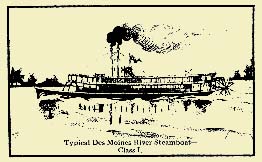
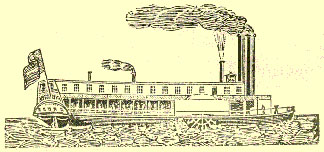
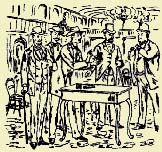


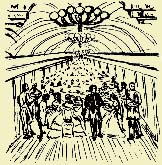 amous
for their excellent meals. Many compare favorably with the meals served
in the finest restaurants of New York and New Orleans. The dinners include
several meat or fish courses, vegetables, salads, and elegant desserts.
Wines and liquors are available with
meals. However, on other steamboats the food may not be very
appetizing. Travelers on these boats complain about too much salt
pork, mutton, boiled potatoes and beans. If you are unfortunate in
choosing one of these boats, you'll find the meals coarsely prepared and
greasy.
amous
for their excellent meals. Many compare favorably with the meals served
in the finest restaurants of New York and New Orleans. The dinners include
several meat or fish courses, vegetables, salads, and elegant desserts.
Wines and liquors are available with
meals. However, on other steamboats the food may not be very
appetizing. Travelers on these boats complain about too much salt
pork, mutton, boiled potatoes and beans. If you are unfortunate in
choosing one of these boats, you'll find the meals coarsely prepared and
greasy.